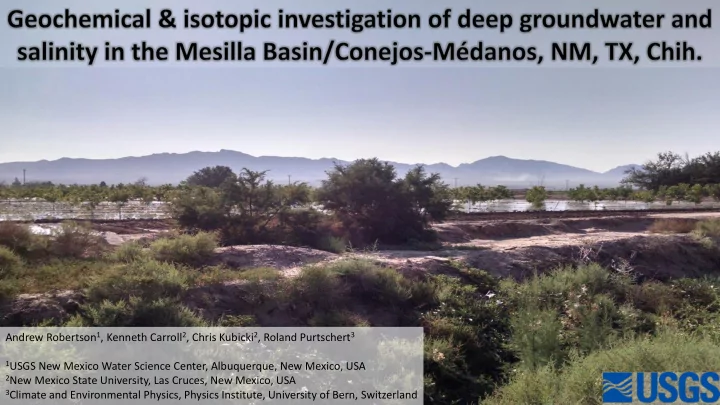

Andrew Robertson 1 , Kenneth Carroll 2 , Chris Kubicki 2 , Roland Purtschert 3 1 USGS New Mexico Water Science Center, Albuquerque, New Mexico, USA 2 New Mexico State University, Las Cruces, New Mexico, USA 3 Climate and Environmental Physics, Physics Institute, University of Bern, Switzerland
Mesilla Basin/Conejos-Médanos Study Area • Study area lies within the Rio Grande Rift Basin. • General groundwater flow direction is towards the river and from north to south. • The Mesilla Basin is about 1,100 square miles (sq mi) and includes as much as 200 sq mi in Chihuahua (Hawley and Kennedy, 2004) • Santa Fe aquifer is up to 3,000 feet thick and consists of late Cenozoic alluvial deposits. The Sante Fe is overlain by recent river deposits. • The conjunctive use of water in the Mesilla Basin Generalized groundwater takes place under a myriad of legal constraints flow direction including the Rio Grande Compact, an international treaty, and a federal water project.
Motivation for work in Mesilla Basin/Conejos-Médanos • Declining water levels, deteriorating water quality, and increasing use of water resources by municipal, industrial, and agricultural water users on both sides of the international border have raised concerns about the long-term availability of the resource in the region (Alley, 2013). • In 2014, initial NAWQA results suggest Mesilla that geothermal waters and brines are Basin sources of natural contaminants to Reach public supply wells in the Rio Grande aquifer system. Dissolved-solids concentration at selected sites in the Rio Grande study area from 1934 to 1999 (Wilcox, 1968; Williams, 2001); from Moyer and others, 2013
Geochemical and isotopic investigation of deep groundwater and salinity in the Mesilla Basin, New Mexico Conventional groundwater sampling • Sampled 17 nested wells in the Mesilla Valley (and 7 single- completion wells in adjacent basins) • Constituents: • major ions, • trace elements, • stable isotopes of water ( δ 18 O, δ D), • strontium ( 87 Sr/ 86 Sr), • boron ( δ 11 B) isotopes, • uranium isotopes ( 234 U/ 238 U), • carbon isotopes ( δ 13 C and 14 C) of dissolved inorganic Area of carbon, upward vertical • noble gas concentrations, and gradients • helium isotope ( 3 He/ 4 He) ratios.
Geochemical and isotopic investigation of deep groundwater and salinity in the Mesilla Basin, New Mexico Conventional groundwater sampling – Residence Time Mixed Modern Helium accumulation *pmC – Percent modern carbon relative to the NBS I oxalic acid standard, corrected for decay since 1950, but not normalized for 13 C fractionation.
Geochemical and isotopic investigation of deep groundwater and salinity in the Mesilla Basin, New Mexico Conventional groundwater sampling – Evaporite Dissolution 0 200 Well depth (feet below land surface) 400 600 800 1,000 1,200 1,400 Saline, brackish & Fresh geothermal water 1,600 (Witcher and Brackish 1,800 others, 2004) Saline 2,000 - 500 1,000 1,500 2,000 2,500 3,000 Cl/Br
Geochemical and isotopic investigation of deep groundwater and salinity in the Mesilla Basin, New Mexico Conventional groundwater sampling - Geothermal
Geochemical and isotopic investigation of deep groundwater in the Mesilla Basin, New Mexico Ultra-trace groundwater sampling • Sampled 8 wells within the Mesilla Valley for • Krypton -81 ( 81 Kr); half-life = 229,000 y • Krypton -85 ( 85 Kr); half-life = 10.756 y • Argon -39 ( 39 Ar); half-life = 269 y • Conservative behavior, advantageous decay rates
Geochemical and isotopic investigation of deep groundwater in the Mesilla Basin, New Mexico Ultra-trace groundwater sampling by degassing • Current extraction efficiency is approximately 50%. • ~1600 gallons to extract 40L of dissolved gases. • Head loss of ~1.5 gpm primarily due to 250 mm filters • General procedure 1. Leak test (~20 psi) with nitrogen, 2. Evacuate system with vacuum, 3. Purge system with dissolved groundwater gas, and 4. Collect sample. • 85 Kr and 39 Ar is being analyzed by Low Level Counting (LLC) at University of Bern. • 81 Kr and 85 Kr is being analyzed at Argonne National Laboratory with Atom Trap Trace Analysis (ATTA).
Geochemical and isotopic investigation of deep groundwater in the Mesilla Basin, New Mexico Preliminary results • Tritium results agree with 85 Kr results indicating no atmospheric contamination. • The 81 Kr analysis show no decay in 6 samples analyzed. • The 39 Ar piston flow ages were far younger than the radiocarbon ages in the samples collected from wells in the southern basin. • High Helium/Neon (He/Ne) indicate mantle and radiogenic sourcing of He and possibly terragenic production of *R/Ra is the ratio of 3He/4He in the sample to the ratio in air 39 Ar.
Geochemical and isotopic investigation of deep groundwater in the Mesilla Basin, New Mexico Summary • Need for continued analysis of groundwater flow patterns, and salinity sources and contributions • Complex groundwater flow system without clear depth-dependent relations and multiple sources of salinity • Benefits of multi-tracer approach • Distribution and source of dissolved solids • Determine groundwater source and mixing • Benefits of ultra-trace sampling approach • Constrain age estimates • Additional conservative tracer for confirming mixing models
Geochemical & isotopic investigation of deep groundwater and salinity in the Mesilla Basin/Conejos-Médanos, NM, TX, Chih. Questions?
Recommend
More recommend